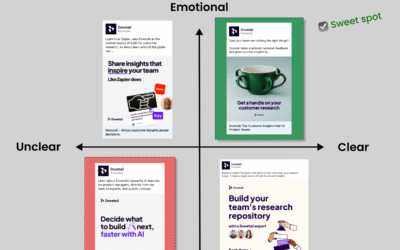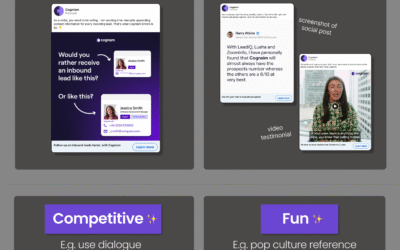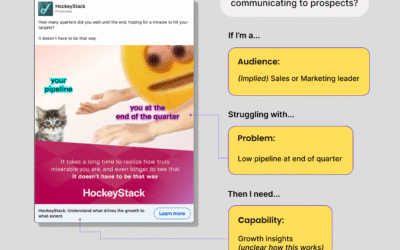
By Myra Ahmed

Creating LinkedIn ads often gives me analysis paralysis. Should the ad focus on this feature… or that benefit… or that one customer testimonial… or…? 🫠
I faced that struggle this week.
Here’s how I solved my overwhelm and felt waaay more confident.
How to find the 3 best messages to use in LinkedIn ad creative.
So I’m planning ads for a cold audience.
The pressure’s on, not gonna lie. I want to impress my client with the results – these ads need to be killer.
Problem is – it’s super hard to get an unfamiliar customer’s attention. How can I create ads that will get clicks?
Here’s what I did.
I found the product’s 3 most compelling value props… by using maths. 🤓
I used FletchPMM‘s epic framework on “How to find your most compelling features”. Essentially, you rate your ICP’s biggest pain-points and your product’s most impressive capabilities out of 10.
Let’s break it down.
Step 1) List out the target customers’ current workflow.
For each of these activities, rate how painful they are for your ICP from 1 to 5 (5 being the severest pain).
E.g. for an ICP trying to create a product roadmap manually – the most painful activities could be:
- Manually collecting research from different sources. (5/5)
- Aligning product strategy with stakeholders. (5/5)
Step 2) List out your capabilities (features) for each of these workflow activities.
For each of your capabilities, rate how compelling they are in your ICP’s eyes – from 1 to 5 (5 being the most impressive).
E.g. for an ICP trying to create a product roadmap manually – Productboard’s most compelling capabilities could be:
- Visually prioritize features based on user demand and business impact. (5/5)
- Visually layout your roadmap with milestones. (5/5)
Step 3) Add up the scores for the pain-point and the capabilities – to get a final score out of 10.
Ta-da! The top 3 highest scorers get turned into ads.
E.g. in Productboard’s case, one of those 3 best messages could be:
Manually collecting research from different sources is too time-consuming. (5/5)
→ Instead, automatically collect user feedback with our dashboard. (4/5)
Final score = 9/10.
They can hook ICPs with that pain-point in their ads.
_________
So that’s how you can feel more confident and strategic with your LinkedIn ad copywriting decisions. By focusing on what your ICP does currently and rating your capabilities.
Not just guessing your way through. ✊💫
___________
Want to use FletchPMM‘s framework in the image above? You can access the Figma file by clicking here.

Writer: Myra Ahmed
Punchy copywriter for LinkedIn ads and landing pages.
More posts on LinkedIn ad copywriting:
How to write LinkedIn ad copy that resonates: nail both clarity *and* emotion.
Here's how to write LinkedIn ad copy that resonates... Hit both co-ordinates on the Clear-Emotional Matrix: make sure your messaging is both clear and emotional. How to write clear LinkedIn ad copy:...
How to use spicy storytelling in your LinkedIn ad copywriting – 4 ad hooks to try
Writing ad creative is f*cking hard. Take it from me - I'm an ad copywriter for a living! 😅 Sometimes you don’t know whether to focus on pain-points or benefits or social proof... HELP. But it...
Before you write funny LinkedIn ads – make sure your storytelling is *clear* (not just clever).
A lot of SaaS teams get excited to write fun LinkedIn ads, thinking it'll grab attention. But if your ad is not clear on what your product does... your impact might be limited. I found a rarity! A...



